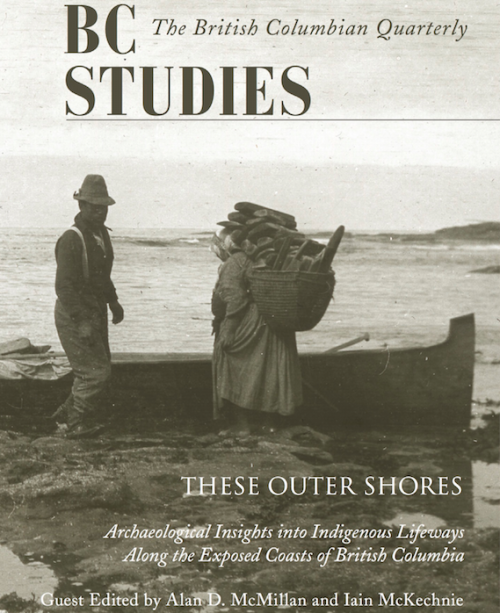 The regional journal BC Studies has a new special issue out focused on local archaeology. Entitled These Outer Shores, the edition is available for a reasonable price (20$) and two of the articles plus the forward are already open access, with the rest to follow in a couple of years. The publisher’s blurb gives a good sense of the edition:
The regional journal BC Studies has a new special issue out focused on local archaeology. Entitled These Outer Shores, the edition is available for a reasonable price (20$) and two of the articles plus the forward are already open access, with the rest to follow in a couple of years. The publisher’s blurb gives a good sense of the edition:
Guest Edited by Alan D. McMillan and Iain McKechnie, These Outer Shores presents recent archaeological research along the outer coast, from southeast Alaska to the entrance to Juan de Fuca Strait. The authors challenge the long-held perception of the western edge of British Columbia as “peripheral” or “remote,” removed from major cultural developments emanating from more interior locations. Instead, recent fieldwork and analyses document a lengthy and persistent occupation of the outer shores over the past 13,000 years. Using a variety of modern approaches and techniques, the authors examine such topics as changing sea levels, human settlement history, fish and shellfish harvesting, whaling, and the integration of Indigenous oral history with archaeology.
The table of contents can be viewed here or here (JPG), but for ease, here it is, below. I’m including a snippet of introduction or conclusion that captures the focus of the paper. I’ve also stuck in an exemplary illustration from each chapter above the entry. My day job’s library seems to only have terrible access to BC Studies via “ProQuest” which has no illustrations or PDFs and a much-mangled text. They will take you to the OJS site, but without access to the locked PDFs. Maybe I am doing something wrong. As I’ve posted before, the older archives of BC Studies (>3 years?) are all open access and can be downloaded as PDFs. Anyway, the following gives a good idea of the journal’s content.
 Overview: Investigating Indigenous Adaptations to British Columbia’s Exposed Outer Coast. Alan McMillan and Iain McKechnie. [PDF link]
Overview: Investigating Indigenous Adaptations to British Columbia’s Exposed Outer Coast. Alan McMillan and Iain McKechnie. [PDF link]
The authors in this volume present recent archaeological research in the important but relatively underexplored outer coast region, showcasing the continuous human presence over the longue durée, or the broad scale of human history that occurs beyond the history of individual events (Braudel 1970). Such a perspective accommodates the extended periods of time represented in the deep archaeological deposits of the outer coast, while also recognizing the short-term everyday activities repeated over many generations that formed the material record investigated archaeo- logically. Although in many areas of the outer coast the earliest traces of human presence have been lost to the encroaching sea, other locations reveal evidence of human settlement that spans about thirteen thousand years (Fedje et al. 2011; McLaren et al., this vol.). Persistent long-term ties between people and specific places are demonstrated in the archaeological record, in oral traditions, in systems of ownership rights to land and resources, and in deep-seated cultural practices stemming from regular and repeated use of the land and sea over generations. Rather than the popular view of much of the outer coast as a “wilderness,” archaeological research, oral traditions, and Indigenous knowledge clearly situate these outer coast places as familiar “homelands” that sustained substantial populations of diverse human cultures over millennia.
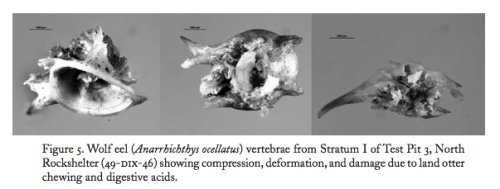 An Ethnozooarchaeological Study of Land Otters and People at Kit’n’kaboodle (49-DIX-46), Dall Island, Alaska. Madonna Moss.
An Ethnozooarchaeological Study of Land Otters and People at Kit’n’kaboodle (49-DIX-46), Dall Island, Alaska. Madonna Moss.
Traditionally, the land otter was the shaman’s most potent spirit helper, or ye’ik. This animal has captured the imagination of many people, has been fodder for contemporary novelists and bloggers, and one can easily find popularized and corrupted versions of ancient Tlingit stories on the internet and in bookstores.
This article is not primarily about Kóoshdaa kaa, however; instead, it addresses the behaviour of Lontra canadensis, as decipherable from remains at Kit’n’Kaboodle (49-DIX-46), an archaeological site on the west side of Dali Island in southeast Alaska. As I describe, this place was inhabited both by people and land otters at various times in the ancient and recent past, spanning more than fifty-five hundred years. Relying predominantly on zooarchaeological data, I present evidence for the human occupation of the site at various times during the spring and/or summer seasons over thousands of years. Based on field observations, wildlife studies, and the analysis of dense lenses of tiny fish bones, the site was occasionally occupied by land otters. Herein I describe how faunal remains deposited by people were distinguished from those deposited by land otters. I propose that what is revealed at Kit’n’Kaboodle helps explain why Tlingit have had such a special, long-term cultural relationship with land otters.
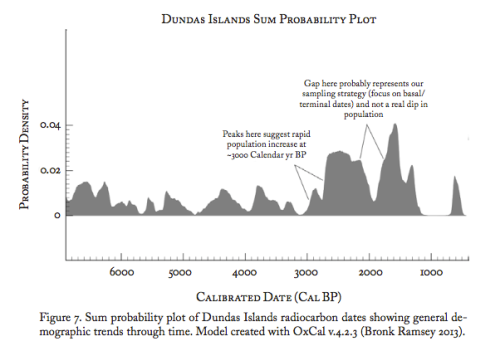 Holocene Settlement History of the Dundas Islands Archipelago, Northern British Columbia
Holocene Settlement History of the Dundas Islands Archipelago, Northern British Columbia
Bryn Letham, Andrew Martindale, Duncan McLaren, Thomas Brown, Kenneth M. Ames, David J.W. Archer, Susan Marsden
Because southeast Alaska and British Columbia were covered by ice of different thicknesses in different areas (e.g., Carrara, Ager, and Baichtal 2007), and because tectonic conditions and events vary from place to place, relative sea level histories are also very localized (Shugar et al. 2014).\n More broadly, it provides a long-term snapshot of the lifeways of offshore island occupation of the Northwest Coast. In subsequent millennia, a variety of village layouts appeared on the islands, the largest of which have differentially sized houses and can be characterized at the most general level by either straight linear house rows or curved house rows, which may be indicative of different cultural groups occupying the islands.
Zooarchaeological and Isotopic Insights into Locally Variable Economic Patterns: A Case Study from Late Holocene Southern Haida Gwaii, British Columbia
Trevor J. Orchard, Paul Szpak
The detailed synthesis and analysis of late Holocene zooarchaeological data from Haida Gwaii presented here reveals a pre-European contact pattern of small, dispersed settlements that focused on a variable array of local subsistence pursuits deriving from their particular historical and ecological circumstances. In the late pre-contact and early European contact periods these data further highlight a shift to larger, centralized, amalgamated villages drawing resources from wider, regional catchment areas facilitated by increased seasonal mobility. Significantly, these suggestions are not new but, rather, fit very well within a range of previous archaeological, oral historical, and ethnographic sources that clearly highlight aspects of these demographic, cultural, and economic shifts within the late Holocene in Haida Gwaii (e.g., Acheson 1985,1998, 2005; Swanton 1905).
This view of the locally variable subsistence economies of late Holocene Haida Gwaii stands in stark contrast to broad, general, homogenizing coastwide models that have often dominated discussions of subsistence and cultural development in coastal British Columbia.
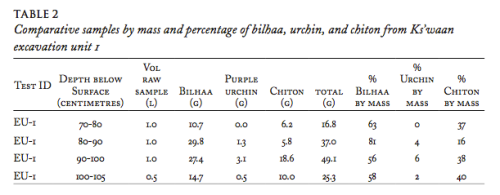
Revisiting “Dm Sibilhaa’nm da Laxyuubm Gitxaała (Picking Abalone in Gitxaała Territory)”: Vindication, Appropriation, and Archaeology
Charles R Menzies
Bilhaa [abalone] have always been there. We have always had them, have always known how to find them, have always eaten them, shared them, and traded them. We have always known this. It is only in the context of colonization that our memories have been challenged. Experts on culture, history, language, and laws think that they can correct us with their external systems of disbelief and compel us to deny what we know. So delicious that these same experts must now sit down at our table and be served up a platter of bilhaa that we have found with their very own tools and techniques.
My search for bilhaa has taken me out into my ancestral home, over the waterways, and ashore at villages and places Gitxaala have always known and valued. As we took up the shovels and trowels of archaeology, as we appropriated their ways as our own, we knew that we could now say yet again what we have always known to be true: we have always harvested bilhaa and we intend to continue doing so well into our future.
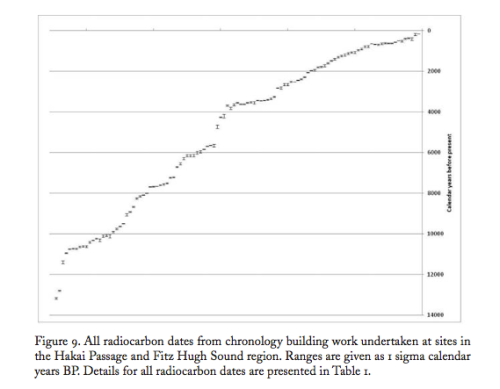
Prerogatives, Sea Level, and the Strength of Persistent Places: Archaeological Evidence for Long-Term Occupation of the Central Coast of British Columbia [link to PDF]
Duncan McLaren, Farid Rahemtulla, Gitla (Elroy White), Daryl Fedje
This article presents the results of chronological assessments of deep and highly stratified archaeological sites on the central coast of British Columbia. Four of the archaeological sites have evidence of repeated occupation spanning at least ten thousand years. An additional five sites have evidence of at least five thousand years of residential use. A stable sea level in the region allowed people to gain access to the same shoreline over long periods of time, resulting in the accumulation of deep archaeological sites. Cultural factors contributing to the longterm accumulation of materials are based on the interrelated system of prerogatives that includes origin stories, property title, and inheritance.
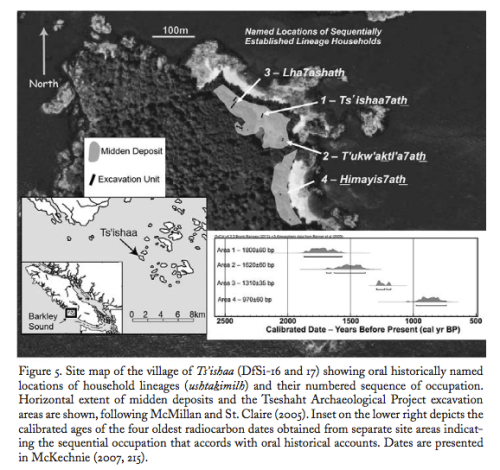
Indigenous Oral History and Settlement Archaeology in Barkley Sound, Western Vancouver Island [link to PDF]
Iain McKechnie
In this article, I have examined an area of the outer coast, using detailed oral historical accounts and archaeological information that document multi-faceted community-level changes during the contact era and over the past three thousand years. The oral historical information and archaeological data indicate that these two distinct ways of considering human history reveal parallel and comparable sequences of settlement, including village establishment, expansion, and the construction of a fortress to ensure continued control over specific territory. Combined, these oral narratives and physical records offer a stronger basis for evaluating change, continuity, and settlement variability within a local group territory on the outer Northwest Coast (e.g., Moss 2012).
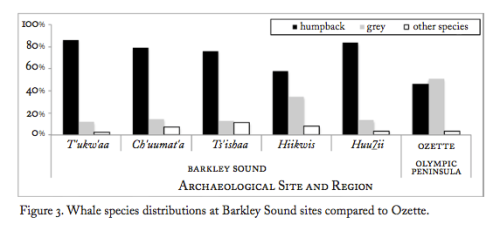 Whales and Whalers in Nuu-chah-nulth Archaeology
Whales and Whalers in Nuu-chah-nulth Archaeology
Alan D. McMillan
MUCH HAS BEEN WRITTEN about whaling among the closely related Nuu-chah-nulth and Makah peoples of western Vancouver Island and the tip of the Olympic Peninsula, along with the pervasive role this practice had in the economic and social systems in these communities. Most sources, however, treat whaling as a single uniform activity, rarely distinguishing between prey species, despite their differing patterns of migration, behaviour, and accessibility. Nor is whaling generally seen in terms of the individual actions and decisions of whaling chiefs, rather than as a more general cultural pattern of community economic activities. This article presents the results of recent studies that identify whale species through bones recovered from archaeological sites in Barkley Sound, western Vancouver Island. It also uses archaeological and ethnographic data to interpret the evidence associated with whaling in terms of the actions of ancient whaling chiefs.

Terrestrial Paleoshoreline Sites on the Northwestern Olympic Peninsula of Washington
Gary C. Wessen, David R. Huelsbeck
THIS ARTICLE ADDRESSES RECENT research on the northwestern Olympic Peninsula of Washington State that focuses upon archaeological sites that appear to be associated with one or more older sea level stands. The sites are located in forest settings between approximately seven and fourteen metres above the top of the modern intertidal zone. Several are located along the flanks of coastal river valleys that would have been bays when the local sea levels were higher. We present background information on the context of these sites, summarize the work that has been undertaken at them, and place the results of our research within the environmental and cultural histories of this region. [note: see blog post here]
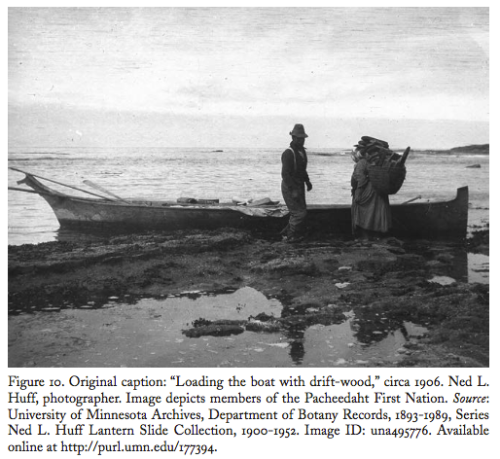 The Minnesota Seaside Station near Port Renfrew, British Columbia (Photo Essay)
The Minnesota Seaside Station near Port Renfrew, British Columbia (Photo Essay)
Erik A. Moore, Rebecca Toov
The images you are sending to us are the earliest photographic records we have of Pacheedaht people, and of their main village. The only other photograph we have of the village, to date, is one taken in 1914 that is very blurry and shows only a part of the village. The most recent photograph you have sent us of the village at the mouth of the San Juan River is exceptionally valuable as it shows all the houses in the village [Figure 7], and also allows us to position the large framed house pictured in one of the earlier photographs you sent to us [Figure 8].8
So, without having read all of this, there’s obviously a lot to like. The last special issue of BC Studies on archaeology was back in 1993, so this is welcome and timely, and at 20$, a real bargain.. There’s been a little more archaeology in the journal outside of the special issues in the last few years, but the journal is still dominated by documentary history at the expense of the 13,000 years of human history preceding settlers. In this, perhaps it resembles the community museums I was being snarky about in a previous case, or, maybe archaeologists just don’t see it as a viable publication outlet.
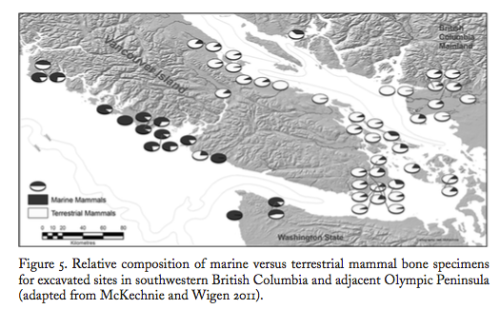
Marine vs. Terrestrial Mammal Use in SW BC Archaeological Sites. Source: McMillan and McKechnie 2015.

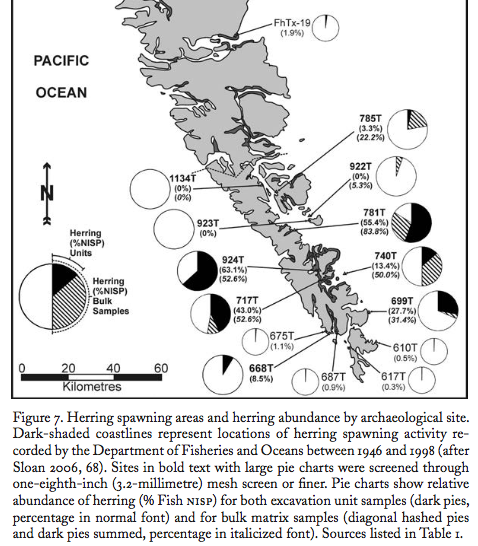

Quentin, thanks very much for this summary and your nice choice of representative illustrations and text. For me as an editor at BC Studies it was a pleasure working with Alan and Iain and all the authors. I’d also like to mention the 17 peer reviewers who took the time and trouble to read and provide their expertise on these articles. If anyone wants to order a copy, please contact the managing editor, Leanne Coughlin, at info@bcstudies.com or write to her at BC Studies, 6303 NW Marine Drive, Vancouver BC, V6T 1Z1 or phone 604 822-3727 Thanks again, Richard
LikeLike
This is way off topic, but I am looking for input to my just posted blog about the name if the site in Desolation Sound popularly called Flea Village. It is on my blog site on my web site Judith Williams.com. Would really like to at least add a native name to this pretty special place. I am a devoted follower of this site. Thanks.
LikeLike
Kit’ n ‘Kaboodle–the coincidence of this people and the term kit and caboodle to mean “pretty much everything” is worth investigating. The term is American in every reference, and the definition has that lazy trait of repeated reference to a set bit of research. Kit is described as a military pack, and caboodle is –well the best reference offered was from olde English.
The possibility that the people gave rise to an expression to demonstrate that a whale hunter , fur trader of the ship that had pretty much gone to the edge, for that eastern seaboard voyage would indeed be the whole kit and caboodle.
This is my take but actually what a LOOLLAPALOOZA of an idea.
Ralph Heading
Pacific Coast Exploration Society
LikeLike
I wasn’t able to find out why the site was named Kit’n’kaboodle, but the earliest reference to it that I know of is in a paper presented by Risa Carlson at the 1993 meeting of the Alaska Anthropological Association. My guess is that a caver or a Forest Service employee gave it this name. Of course an indigenous name would be preferable.
LikeLike
So instead of the name being indigenous, its just an old expression dressed up with diacritical marks to look anthropologic. Good story about bad referencing.
LikeLike
Q, Just to say that U o Toronto library has same issue with ProQuest downloads. Lots of things to learn in this amazing issue, among them, it’s great to see Denis St. Claire’s toponomical work being used in an innovative fashion.
LikeLike
Q and MadDog, I have also found it a challenge to know where to best access online issues of BC Studies.
However, I’ve found that the best point is via the Open Journal Systems (OJS) link: http://ojs.library.ubc.ca/index.php/bcstudies/index
This is where all the articles older than 2 years can be downloaded for free including Charles Borden’s 1968 article on the Skagit River Atlatl in the very first issue:
http://ojs.library.ubc.ca/index.php/bcstudies/article/view/579/622
and all the way up to Dana Lepofsky and Nancy Turner’s excellent special issue on Ethnobotany in 2013:
http://ojs.library.ubc.ca/index.php/bcstudies/issue/view/182476
As for within the past 2 years, I also share your experience in that I find that Proquest is a poor pathway to read BC Studies articles (as well as other journals). The same goes for several other companies claiming to provide ‘access’ (e.g., EBSCO host, CBCA Reference, GaleGroup etc.). These ‘bundled’ service provides offer very clunky access and seem to duplicate each other (at what cost to the university I wonder).
For instance, A quick survey of the UVic, UBC, and SFU libraries shows each institution has at least five different ways to access the journal but several represent these duplicated access points. Plus while the bundlers all seem to offer access to ‘recent’ issues, several lag well behind the actual publication schedule and don’t list the most recent issue. Some only offer issues that go back to 2008 even though the actual archive is available for free via OJS.
Bottom line is always choose the Open Journal Systems (OJS) link from your institutional library page when reading BC Studies or subscribe to the journal.
LikeLike
Hi all. Just to add to Iain’s notes. UofT does have a subscription via the OJS system. However, for some reason I see that it does not show up when searching through the library. When I simply go directly to the OJS page (Iain has the link above), then I can access all the content via the UofT subscription, provided I am on campus. MadDog, if you first sign in to the UofT library access and then surf directly to the OJS page, you may be able to get this access? And I suspect the same may be true for UVic, though I can’t test that.
Thanks for the coverage of this issue, Q. And thanks to Iain, Alan, Richard, and all at BC Studies for producing a great volume.
LikeLike
OK part of the problem at least is that the symbols don’t change for me indicating whether it is currently locked or unlocked PDF. I came in while logged in to UVIC and on the UVIC VPN and it is now allowing me all access at the OJS link, however, as the screenshot below shows, the symbol for locked/unlocked doesn’t change. So, don’t trust the symbol and try anyway may be part of the issue? Or read the explainer and see that sometimes the yellow symbol will mean, no access to you at this time, and sometimes it will mean, you have access but sometimes you won’t. If that makes sense. I guess it is slightly different than what I am used to…..
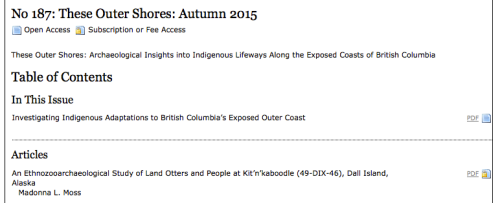
LikeLike
Yes, same deal here. Open access papers are “unlocked”; all others are “locked” despite the fact that I have access to all through the institutional subscription. So just ignore the symbols and click on the PDF link.
LikeLike
Q, Many thanks for posting this summary.
Richard, thanks for posting info on where one can buy physical copies. As guest editors, Alan and I are grateful to Richard and the rest of the journal staff for their extensive help and advice throughout the production of the volume. Most importantly we are thankful to the contributors and the many institutions and communities that supported their research.
LikeLike
Pingback: These Outer Shores: A special edition of BC Studies | Nicole A. Raslich
Q and all, I very much look forward to getting a copy of this monumental work. I ordered a physical copy from the U.S. and even got a personal e-mail note from B.C. Studies staff thanking me for ordering it and that mine had just shipped.
I am currently on “these outer shores” at my Hoko cabin watching two surfers still out there into darkness…. Anyway my book could have arrived at home by now in Tumwater. I will check with my wife tonight.
My CONGRATULATIONS to all for this work and this will be a great addition to our science. As an aside, I love the classic West Coast burden basket on the cover–this is the main ancient basket (50+) from the ~3000 year old Hoko wet site up the flooding river from me here. Best to all, Dale
LikeLike
Hi Dale, yes, the special issue came out very well and is selling rapidly. I remember your neighbourhood there at Hoko from the summer of 1980. Glad to know you are still resident! Regards, Richard
LikeLike
Richard: Yes we have cross-Straits archaeology surfers meetings here–last fall we had surfing stars, Iain (really good, with daughter), Morley and Chris, Duncan (with daughter) and US star Scott Williams (WSDOT) and his neighbor. Plus ace cooks Tyler (WSDOT) and Ina. Unfortunately Quentin was a car or two from getting on the Black Ball and did not make it over–maybe next time with your brother Al. All hang-10 delegates went out to the Makah Museum, Cape Flattery and we had baked salmon, steamed mussels/barnacles and over-indulged in my specialty, black katy chitons….The big question–does Richard surf?! (I watch).
In regards to new synthesis volume, I need to point out that my wife said my BC Studies arrived in Tumwater in yesterday’s mail! Now that this amazing storm is over, I will be able to head home tomorrow–Hoko is really moving. Best to all, Dale
LikeLike
Thanks, Dale, good to hear from you. No I don’t surf but get vicarious pleasure from seeng Morley Eldridge’s exploits on Facebook. He is another old archaeology boss of mine…. he seems much more reckless now than he was at Hope in 1977! Glad the special issue arrived and look forward to your opinion, Richard
LikeLike